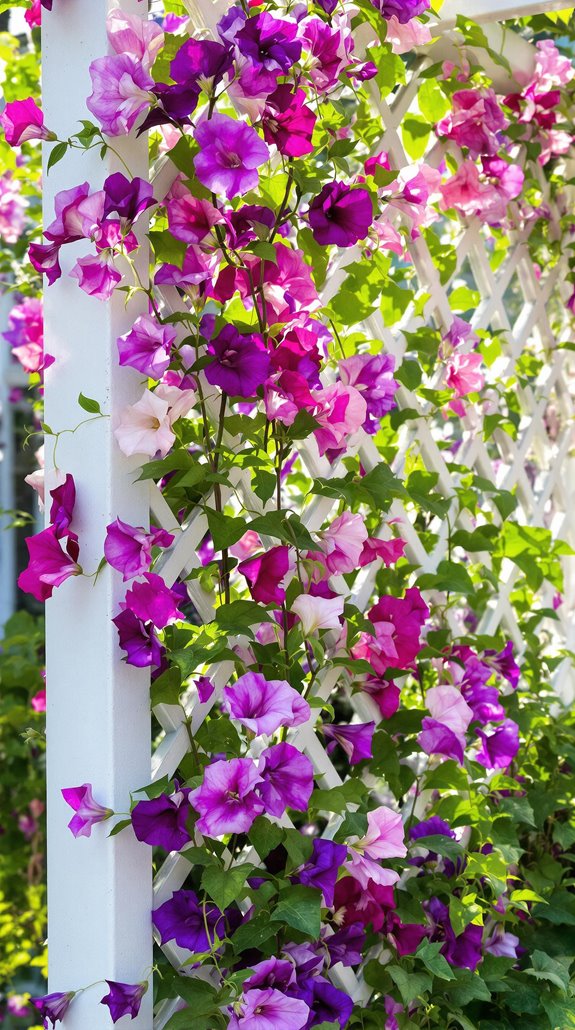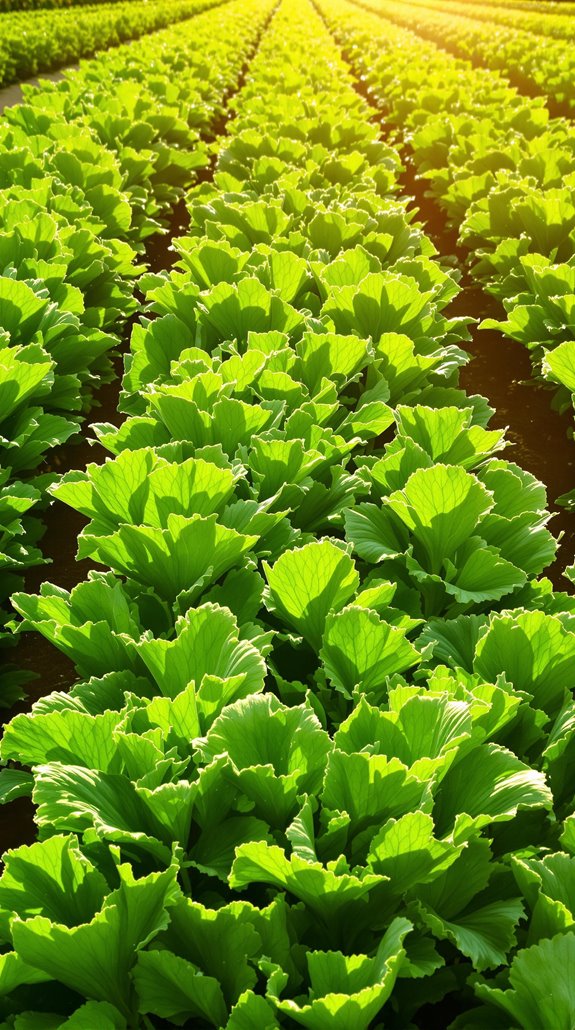10 Lightning-Fast Growing Plants for the Impatient Green Thumb
If you're as impatient as I am about gardening results, I've got the perfect speed-growing plants for you. You can harvest crisp radishes in just 20 days, snip tender microgreens in a week, and watch bamboo shoot up 3 feet in 24 hours. Morning glories will race up your trellis, while sunflowers stretch skyward at an inch per day. For quick edibles, try loose-leaf lettuce, zucchini, mustard greens, and pea shoots – all ready in weeks, not months. Sweet peas round out my fast-growing favorites, blooming just 3 months from seed. Let's explore how to jumpstart your instant garden success.
Contents
- 1 Radishes: From Seed to Harvest
- 2 Morning Glory Climbing Vines
- 3 Bamboo: The Rapid Riser
- 4 Fast-Growing Lettuce Varieties
- 5 Sunflowers Reaching for Sky
- 6 Microgreens for Quick Results
- 7 Sweet Pea Success
- 8 Zucchini and Summer Squash
- 9 Mustard Greens in Days
- 10 Pea Shoots and Sprouts
- 11 Frequently Asked Questions
- 11.1 Can Fast-Growing Plants Deplete Soil Nutrients More Quickly Than Slower-Growing Varieties?
- 11.2 What Temperature Ranges Are Ideal for Accelerating Plant Growth?
- 11.3 Do Rapidly Growing Plants Require Special Fertilizers or Supplements?
- 11.4 Are Fast-Growing Plants More Susceptible to Pests and Diseases?
- 11.5 Can Lightning-Fast Growing Plants Be Grown Successfully in Containers Indoors?
Radishes: From Seed to Harvest

For the novice gardener seeking quick results, radishes offer the perfect introduction to growing vegetables. I can assure you these crisp, peppery roots will go from seed to harvest in just 20-30 days, making them one of the fastest-growing edible plants.
I recommend sowing your radish seeds directly into well-draining soil, spacing them about an inch apart and a half-inch deep. You'll see sprouts emerge in 3-7 days. Keep the soil consistently moist but not waterlogged. I've found that full sun produces the best results, though radishes can tolerate partial shade.
When the roots reach about an inch in diameter and their shoulders push up through the soil, they're ready to harvest. Don't wait too long – oversized radishes become tough and bitter.
Morning Glory Climbing Vines

While radishes satisfy our desire for quick edible results, morning glories offer rapid gratification for ornamental gardening. I've found these vigorous climbers can grow up to 10 feet in just two months, making them perfect for covering fences or trellises in record time.
I recommend soaking the seeds overnight and planting them in well-draining soil once frost danger has passed. You'll see sprouts within 5-7 days, and the vines will quickly take off. The heart-shaped leaves appear first, followed by stunning trumpet-shaped blooms in purple, blue, pink, or white that open each morning.
Don't let their fast growth fool you – these plants need proper support. I've learned to guide them early with strings or netting, and they'll reward you with a spectacular flowering display by mid-summer.
Bamboo: The Rapid Riser

Bamboo stands as nature's fastest-growing woody plant, with some species shooting up an astonishing 3 feet in just 24 hours. I've found running bamboo varieties like Phyllostachys to be particularly vigorous, though you'll need to install root barriers to prevent them from taking over your yard.
For a more controlled growth pattern, I recommend clumping bamboos like Fargesia. They'll still give you impressive height quickly, but they won't spread aggressively. I typically plant bamboo in spring when the soil's warmed up to 65°F.
You'll want to water deeply and mulch well during the first growing season. Once established, bamboo's surprisingly drought-tolerant. Just remember: the faster the growth, the more nutrients it needs, so I fertilize monthly during the growing season.
Fast-Growing Lettuce Varieties

Leafy lettuce varieties offer the quickest path from seed to salad bowl, with many types ready to harvest in just 30 days. I recommend starting with 'Black Seeded Simpson' or 'Grand Rapids,' which you can begin harvesting in about three weeks by picking outer leaves.
For even faster results, I suggest trying microgreens or "cut and come again" methods. You'll get baby lettuce leaves in just 10-14 days. 'Red Sails' and 'Salad Bowl' varieties work perfectly for this approach.
To maximize your quick harvest, I've found that loose-leaf varieties outperform head lettuce every time. Plant your seeds 1/4 inch deep, keep the soil consistently moist, and you'll have fresh lettuce before you know it. For continuous supply, I plant new seeds every two weeks.
Sunflowers Reaching for Sky

Among fast-growing plants, sunflowers stand out as remarkable speedsters that can rocket up to 12 feet in just three months. I've found that 'Mammoth' varieties can grow an impressive 6-12 inches per week in ideal conditions. If you're enthusiastic to see results, I recommend planting them in late spring when soil temperatures reach 70°F.
You'll want to choose a spot with full sun and well-draining soil. I always sow seeds directly into the ground about 1 inch deep and 6 inches apart. Don't forget to water deeply but infrequently to encourage deep root growth. Within 7-10 days, you'll see the first sprouts emerge, and before you know it, those tiny seedlings will transform into towering giants with massive flower heads that track the sun's movement.
Microgreens for Quick Results

When you're craving almost instant gratification from gardening, microgreens offer an incredibly fast path to harvest. I've found that these nutrient-packed seedlings can be ready to eat in just 7-14 days, making them perfect for impatient gardeners like me.
I recommend starting with fast-growing varieties like radish, arugula, or mustard greens. Simply scatter the seeds densely across a shallow tray filled with potting mix, cover them lightly with soil, and mist with water. I keep mine on a sunny windowsill or under grow lights. Once they've sprouted their first set of leaves, I snip them just above the soil level with clean scissors. They're perfect for adding a punch of flavor to salads, sandwiches, or as garnishes, and I can start a new batch immediately after harvesting.
Sweet Pea Success

While microgreens offer quick results, sweet peas can satisfy impatient gardeners with their rapid growth and early blooms. I've found that sweet pea seeds germinate in just 7-14 days when you soak them overnight and plant them in well-draining soil. You'll see the first shoots emerge quickly, especially if you maintain soil temperatures between 55-65°F.
For the fastest growth, I recommend starting sweet peas indoors 4-6 weeks before the last frost. Plant them 1 inch deep in biodegradable pots, and provide support once they reach 3 inches tall. I've noticed they grow about an inch per day in ideal conditions. You can expect flowers within 3 months of sowing, making sweet peas one of the quickest flowering vines to reward your patience.
Zucchini and Summer Squash

Zucchini and summer squash burst into production faster than most garden vegetables, making them perfect for impatient gardeners. I can harvest my first squash just 50 days after planting, and they'll keep producing until frost kills the plants.
I'll show you how to maximize your harvest: Plant seeds directly in the ground once soil temperatures reach 70°F, spacing them 3 feet apart. They need full sun and rich, well-draining soil. I add compost before planting and mulch to retain moisture.
Don't wait too long to harvest – I pick zucchini when they're 6-8 inches long and summer squash when they reach 4-6 inches. Check your plants every day, as these vegetables can double in size overnight. One or two plants will provide more than enough squash for a family.
Mustard Greens in Days

If you think zucchini grows fast, you'll be amazed by mustard greens. I can harvest my first tender leaves in just 14 days from sowing, making them one of the quickest crops you can grow. The entire plant matures in 30-40 days, providing continuous harvests throughout the season.
I recommend planting mustard greens in partial shade during summer to prevent them from becoming too spicy or bitter. They're incredibly low-maintenance – just keep the soil moist and harvest the outer leaves regularly. You can grow them in containers, raised beds, or directly in your garden.
For a constant supply, I plant new seeds every two weeks. The leaves add a peppery kick to salads when young and provide a more robust flavor for cooking when mature.
Pea Shoots and Sprouts

Growing pea shoots offers one of the fastest paths to fresh greens, with harvests possible in just 7-10 days from sowing. I've found that any pea seeds work well – from snow peas to garden peas – and you don't need special equipment to get started. Simply scatter your pea seeds densely across moistened potting soil, cover them lightly, and wait.
I recommend harvesting when the shoots reach about 4 inches tall. Just snip them above the first set of leaves, and they'll often regrow for a second harvest. You can even grow pea shoots without soil by sprouting them in a jar with daily rinsing. The tender shoots taste just like sweet garden peas and pack more nutrients than mature pea plants. I love adding them to salads, sandwiches, and stir-fries.
Frequently Asked Questions
Can Fast-Growing Plants Deplete Soil Nutrients More Quickly Than Slower-Growing Varieties?
Let me share a dirty little secret about those speedy plant superheroes: Yes, I can tell you that fast-growing plants are total nutrient hogs! They'll gobble up soil nutrients much quicker than their slower cousins because they're building tissue at warp speed. I always remind gardeners that these rapid growers need more frequent fertilizing to keep up with their demanding appetites. It's like feeding hungry teenagers versus toddlers!
What Temperature Ranges Are Ideal for Accelerating Plant Growth?
I'll tell you the ideal temperature ranges for speeding up plant growth. Most plants thrive between 70-85°F (21-29°C) during the day and slightly cooler at night, around 65-75°F (18-24°C). I've found that maintaining these ranges accelerates photosynthesis and metabolic processes. However, I should mention that each plant species has its sweet spot – tropicals prefer warmer temps while cool-season vegetables grow best in lower ranges.
Do Rapidly Growing Plants Require Special Fertilizers or Supplements?
You won't believe how hungry these speed-demon plants can be! I'll tell you straight up – yes, rapidly growing plants need an extra nutritional boost. I always use a balanced NPK fertilizer (nitrogen, phosphorus, potassium) with slightly higher nitrogen content for that explosive growth. I've found that adding organic supplements like fish emulsion or seaweed extract works wonders too. Just don't go overboard – these power-hungry plants can burn from too much fertilizer!
Are Fast-Growing Plants More Susceptible to Pests and Diseases?
In my experience, fast-growing plants are often more vulnerable to pests and diseases. I've found that their rapid growth produces softer, more tender tissues that insects love to munch on. They're also putting so much energy into quick growth that they don't develop strong natural defenses. I'll tell you though, while they need more attention, you can prevent most problems by monitoring regularly and maintaining good air circulation.
Can Lightning-Fast Growing Plants Be Grown Successfully in Containers Indoors?
Yes, I can tell you that many fast-growing plants thrive in indoor containers. I've had great success growing bamboo, pothos, and spider plants in my home. You'll want to choose containers with good drainage and use quality potting soil. Just keep in mind that these speedy growers might need larger pots or more frequent repotting than slower-growing plants. They'll also need adequate light and regular fertilizing.
